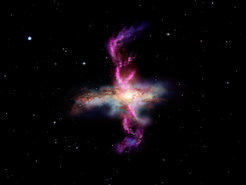Analysis keeps on going as observations with Herschel come to an end
Observations on ESA's Herschel space observatory ceased on 29 April, as the supply of liquid helium coolant on board the spacecraft had completely evaporated. The most powerful infrared telescope ever flown in space, Herschel operated at far-infrared and sub-millimetre wavelengths, being sensitive to a wide range of low temperatures from a few hundred to less than ten degrees above absolute zero. Herschel carries three science instruments: a high-resolution spectrometer, HIFI (Heterodyne Instrument for the Far Infrared), and the two cameras and imaging spectrometers, SPIRE (Spectral and Photometric Imaging REceiver) and PACS (Photodetector Array Camera and Spectrometer). Scientists from the Max Planck Institute of Extraterrestrial Physics were involved in many aspects of the mission, starting with the development and construction of PACS, and leading several key programmes such as SHINING and PEP.
SHINING, the Survey with Herschel of the ISM in Nearby INfrared Galaxies, is a Herschel guaranteed time key programme of the .PACS consortium. Its aim is to study star formation and activity in infrared bright galaxies at local and intermediate redshifts. The programme consists mostly of a large and coherent spectroscopic and photometric survey with PACS, but also includes some SPIRE photometry.
PEP, the PACS Evolutionary Probe is a Herschel guaranteed time key programme survey of the extragalactic sky, aimed to study the rest-frame far-infrared emission of galaxies up to redshift ~3, as a function of the environment. With the help of the deep images obtained with PEP since 2010, the majority of the cosmic infrared background has been resolved into individual sources. Some 50 scientific papers by the PEP team study galaxies in the young universe. During these early evolutionary stages, galaxies have access to a much larger supply of fresh gas and can build stars very rapidly. “We just finished processing the images obtained in the framework of PEP, and released the data to the scientific community” says Dieter Lutz from MPE, leader of the PEP Herschel key programme. “This does not only give the deepest view of the infrared sky in the selected fields, together with observations at other wavelengths it also provides interesting insights into the evolution of galaxies and their star formation.”

Far-infrared images of the regions of the sky studied by PEP
The change in star formation rates over cosmic timescales may be linked to the supermassive black hole assumed to exist at the centre of most galaxies. In so-called active galaxies, the central black hole feeds on the surrounding matter at extraordinarily high rates. The radiation pressure created by this accretion triggers an outflow of material, which may drain the galaxy's reservoir of gas and quench its star formation.
“By monitoring a number of relatively nearby active galaxies with Herschel, we have detected, for the first time, vast amounts of outflowing gas that is molecular in nature,” comments Albrecht Poglitsch from MPE, who is Principal Investigator of PACS. “This shows us that these outflows may indeed deplete a galaxy's supply to form stars, since it is from molecular gas that stars are made,” he adds.

This illustration shows an Ultra-Luminous InfraRed Galaxy (ULIRG) that exhibits massive outflows of molecular gas.
Another highlight from Herschel is the study of the chemical composition of cosmic objects through high-resolution spectroscopy, and in particular the search for water in a variety of environments.
Astronomers worldwide have so far used Herschel data to produce over 600 scientific papers published in refereed journals. But this is only the beginning: the careful analysis of Herschel's images and spectra will generate many more science discoveries and new insights for years to come.













